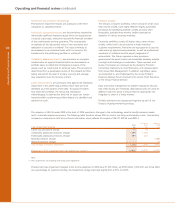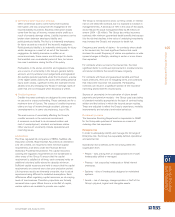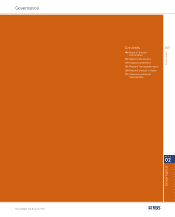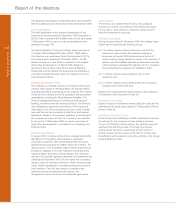RBS 2005 Annual Report Download - page 103
Download and view the complete annual report
Please find page 103 of the 2005 RBS annual report below. You can navigate through the pages in the report by either clicking on the pages listed below, or by using the keyword search tool below to find specific information within the annual report.
section
01
Operating and
financial review
101
Operating and financial review
Annual Report and Accounts 2005
Non-trading
The principal market risks arising from the Group’s non-trading
activities are interest rate risk, currency risk and equity risk.
Treasury activity and mismatches between the repricing of
assets and liabilities in its retail and corporate banking
operations account for most of the non-trading interest rate
risk. Non-trading currency risk derives from the Group’s
investments in overseas subsidiaries, associates and branches.
The Group’s venture capital portfolio and investments held by
its general insurance business are the principal sources of
non-trading equity price risk. The Group’s portfolios of non-
trading financial instruments mainly comprise loans (including
finance leases), debt securities, equity shares, deposits,
certificates of deposits and other debt securities issued, loan
capital and derivatives. To reflect their distinct nature, the
Group’s long-term assurance assets and liabilities attributable
to policyholders have been excluded from these market risk
disclosures.
●Interest rate risk
Non-trading interest rate risk arises from the Group’s treasury
activities and retail and corporate banking businesses.
Treasury
The Group’s treasury activities include its money market
business and the management of internal funds flow within the
Group’s businesses. Money market portfolios include cash
instruments (principally debt securities, loans and deposits)
and related hedging derivatives. VaR for the Group’s treasury
portfolios, which relates mainly to interest rate risk including
credit spreads, was £3.5 million at 31 December 2005 (2004 –
£5.7 million). During the year the maximum VaR was £5.8
million (2004 – £9.3 million), the minimum £2.8 million (2004 –
£5.7 million) and the average £4.0 million (2004 – £7.3 million).
Retail and corporate banking
Structural interest rate risk arises in these activities where
assets and liabilities have different repricing dates. It is the
Group’s policy to minimise the sensitivity of net interest income
to changes in interest rates and where interest rate risk is
retained to ensure that appropriate resources, measures and
limits are applied.
Structural interest rate risk is calculated in each division on the
basis of establishing the repricing behaviour of each asset
and liability product. For many products, the actual interest rate
repricing characteristics differ from the contractual repricing.
In most cases, the repricing maturity is determined by the
market interest rate that most closely fits the historical
behaviour of the product interest rate. For non-interest bearing
current accounts, the repricing maturity is determined by the
stability of the portfolio. The repricing maturities used are
approved by Group Treasury and divisional asset and liability
committees at least annually. Key conventions are reviewed
annually by GALCO.
A static maturity gap report is produced as at the month-end
for each division, in each functional currency based on the
behaviouralised repricing for each product. It is Group policy
to include in the gap report, non-financial assets and liabilities,
mainly property, plant and equipment and the Group’s capital and
reserves, spread over medium and longer term maturities. This
report also includes hedge transactions, principally derivatives.
Any residual non-trading interest rate exposures are controlled
by limiting repricing mismatches in the individual balance
sheets. Potential exposures to interest rate movements in the
medium to long term are measured and controlled using a
version of the same VaR methodology that is used for the
Group’s trading portfolios but without discount factors. Net
accrual income exposures are measured and controlled in
terms of sensitivity over time to movements in interest rates.
Risk is managed within limits approved by GALCO through the
execution of cash and derivative instruments. Execution of the
hedging is carried out by the relevant division through the
Group’s treasury functions. The residual risk position is
reported to divisional asset and liability committees, GALCO
and the Board.
Non-trading interest rate VaR
Non-trading interest rate VaR for the Group’s treasury and retail
and corporate banking activities was £81.5 million at 31
December 2005 (2004 – £72.4 million) with the major exposure
being to changes in longer term US dollar interest rates.
During the year, the maximum VaR was £104.2 million (2004 –
£89.7 million), the minimum £10.8 million (2004 – £51.5 million)
and the average £65.5 million (2004 – £71.2 million).
Citizens was the main contributor to the Group’s non-trading
interest rate VaR. It invests in a portfolio of highly rated and
liquid investments, principally mortgage-backed securities.
This balance sheet management approach is common for US
retail banks where mortgages are originated and then sold to
Federal agencies for funding through the capital markets.
VaR, like all interest rate risk measures, has its limitations when
applied to retail banking books and the management of
Citizens’ interest rate exposures involves a number of other
interest rate risk measures and related limits. Two measures
that are reported both to Citizens ALCO and the Board are:
•the sensitivity of net accrual earnings to a series of parallel
movements in interest rates; and
•economic value of equity (“EVE”) sensitivity to a series of
parallel movements in interest rates.
























